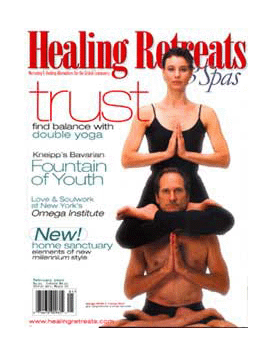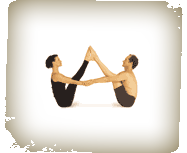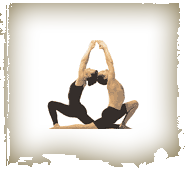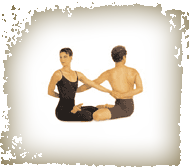Origins of Partner Yoga, by Ganga and Tracey
Reprinted from Millenium issue of Healing Retreats & Spas, January 2000
Interview by Eden Marriott Kennedy

Partners in yoga and in life for the last seventeen years, Ganga White and Tracey Rich are in their studio at the White Lotus Foundation retreat in Santa Barbara, California, stretching themselves into a pose they call "suspension bridge."
Grasping each other's wrists, arms straight, legs straight, angled at the waist, they are slowly dropping back and finding their balance. Looks easy. But it requires some patience, and two hours into a photo session with all-day-empty stomachs, White and Rich are showing us a side of partner yoga that every couple would understand.
Rich (trying to improve her grip on White's arms): "You're not doing it right."
White (amusement hiding his shock): "I invented it!"
Rich (looking at the camera and smiling sweetly): "We're having a double yoga moment."
 Then again, most couples don't have the benefit of having developed a style of yoga that has influenced students and teachers around the world. Double Yoga, first published by Penguin in 1980, was White's brainchild. "It all came as a flash," he says now. "I remember very distinctly when it happened, I was in Los Angeles, and I put one leg behind my head and I was leaning back, supporting myself with one hand, and I thought, wouldn't this be interesting to have someone next to me doing the same posture?" That was 1977, and though the idea seemed purely visual at first - White set up a camera with a timer shot photos of several postures that he had tried with fellow yogi Ana Forrest. He then developed more postures with Forrest, had them professionally shot, and took the pictures to the L.A. Book Fair. An editor from Viking-Penguin was so moved by the concept that she quickly took the pictures from White to keep any other publishing house from stealing him away.
Then again, most couples don't have the benefit of having developed a style of yoga that has influenced students and teachers around the world. Double Yoga, first published by Penguin in 1980, was White's brainchild. "It all came as a flash," he says now. "I remember very distinctly when it happened, I was in Los Angeles, and I put one leg behind my head and I was leaning back, supporting myself with one hand, and I thought, wouldn't this be interesting to have someone next to me doing the same posture?" That was 1977, and though the idea seemed purely visual at first - White set up a camera with a timer shot photos of several postures that he had tried with fellow yogi Ana Forrest. He then developed more postures with Forrest, had them professionally shot, and took the pictures to the L.A. Book Fair. An editor from Viking-Penguin was so moved by the concept that she quickly took the pictures from White to keep any other publishing house from stealing him away.
Double yoga has grown into a practical tool, both for teachers assisting their students and for students supporting other students in postures they may not yet have mastered. "Double yoga was never meant to replace a personal, single yoga practice," says White, "but it can complement a personal yoga practice and add new dimensions. You can use different leverages and weights, it lets you bend in ways you maybe couldn't before, you learn nonverbal communication, literally to feel each other's energy through where you're touching, and to adjust and respond equally to your partner. To stay alert. It teaches you a lot of lessons about relationship." Rich concurs. "If one person pushes too much, you'll both fall over," she says. "It can also help you find compassion for your partner that you might not yet have for yourself."
 Neither Tracey nor Ganga insist that practitioners be of opposite sexes. When done with a partner you're in relationship with, double yoga can mirror the dynamic between the two of you; and if one person is tuning out or being too controlling, yoga can give you a safe place to address those issues. "The polarity of man and woman can be fantastic," says White, "but same-sex partners have their own equally unique energy exchanges and insights." Breath seems to synchronize to new partners right away, bringing connection and attunement. First you have to tune into your own breath and strength, and then you synchronize with a partner. More metaphor for relationship: each partner has to find his or her balance before creating a stable union of two. Yet polarizing the breath, with one partner breathing in while the other breathes out, can create a remarkable seesaw interplay of forces, sometimes so intricate and subtle that "it becomes a tantric practice," says Rich. "It's pure alchemy."
Neither Tracey nor Ganga insist that practitioners be of opposite sexes. When done with a partner you're in relationship with, double yoga can mirror the dynamic between the two of you; and if one person is tuning out or being too controlling, yoga can give you a safe place to address those issues. "The polarity of man and woman can be fantastic," says White, "but same-sex partners have their own equally unique energy exchanges and insights." Breath seems to synchronize to new partners right away, bringing connection and attunement. First you have to tune into your own breath and strength, and then you synchronize with a partner. More metaphor for relationship: each partner has to find his or her balance before creating a stable union of two. Yet polarizing the breath, with one partner breathing in while the other breathes out, can create a remarkable seesaw interplay of forces, sometimes so intricate and subtle that "it becomes a tantric practice," says Rich. "It's pure alchemy."
 White has wondered how much double yoga he actually originated, and how much might have existed as part of past traditions. He's talked to yoga scholars and historians but doesn't see it as having been part of any formal school. He recalls seeing a film from the '30s or '40s of Krishnamacharya's school in India, where there seemed to be the beginnings of a few double postures--two yogis assisting and mirroring each other. "You could see an idea wanting to birth itself," he says. But as yoga students take the idea and develop it to suit their own needs, double yoga has taken on a life of its own, away from the author who now spends his days running teacher trainings and workshops with Rich, or joining his friend Sting on his West Coast concert tour.
White has wondered how much double yoga he actually originated, and how much might have existed as part of past traditions. He's talked to yoga scholars and historians but doesn't see it as having been part of any formal school. He recalls seeing a film from the '30s or '40s of Krishnamacharya's school in India, where there seemed to be the beginnings of a few double postures--two yogis assisting and mirroring each other. "You could see an idea wanting to birth itself," he says. But as yoga students take the idea and develop it to suit their own needs, double yoga has taken on a life of its own, away from the author who now spends his days running teacher trainings and workshops with Rich, or joining his friend Sting on his West Coast concert tour.
The photo shoot is over, but the photographer still has a few frames to burn, and so he asks White and Rich to tilt their heads together for a classic lovers portrait. As White puts his forehead near Rich's cheek, he says, "I think I'm sweating on you." Hugging him closer for one last double yoga moment, she says, "What's a little more sweat between friends?"
Reprinted with permission of Healing Retreats and Spa Magazine, Santa Barbara, California
